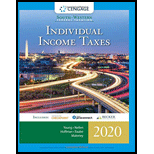
Individual Income Taxes
43rd Edition
ISBN: 9780357109731
Author: Hoffman
Publisher: CENGAGE LEARNING - CONSIGNMENT
expand_more
expand_more
format_list_bulleted
Question
Chapter 9, Problem 6CPA
To determine
Identify the overall limitation to the qualifying business income deduction.
Expert Solution & Answer
Want to see the full answer?
Check out a sample textbook solution
Students have asked these similar questions
Step by step.....?
Please help!!!! I need it bad
A company sells a product for $25 per unit. The variable cost per unit is $15, and the total fixed costs are $50,000.
a) How many units must the company sell to break even?
b) If the company wants a profit of $10,000, how many units must it sell?
Chapter 9 Solutions
Individual Income Taxes
Ch. 9 - Prob. 1DQCh. 9 - Mason performs services for Isabella. In...Ch. 9 - Milton is a resident of Mobile (Alabama) and is...Ch. 9 - In 2017, Emma purchased an automobile, which she...Ch. 9 - Prob. 5DQCh. 9 - Prob. 6DQCh. 9 - Prob. 7DQCh. 9 - Prob. 8DQCh. 9 - Prob. 9DQCh. 9 - Prob. 10DQ
Ch. 9 - Prob. 11DQCh. 9 - Prob. 12DQCh. 9 - Prob. 13DQCh. 9 - Prob. 14DQCh. 9 - Paul wholly owns and operates an office supplies...Ch. 9 - Prob. 16DQCh. 9 - Prob. 17DQCh. 9 - Lara uses the standard mileage method for...Ch. 9 - Fred, a self-employed taxpayer, travels from...Ch. 9 - Prob. 20CECh. 9 - Prob. 21CECh. 9 - In 2019, Robert entertains four key clients and...Ch. 9 - In 2019, the CEO of Crimson, Inc., entertains...Ch. 9 - Prob. 24CECh. 9 - Cindy maintains an office in her home that...Ch. 9 - Prob. 26CECh. 9 - Prob. 27CECh. 9 - Prob. 28PCh. 9 - Prob. 29PCh. 9 - Prob. 30PCh. 9 - In June of this year, Dr. and Mrs. Bret Spencer...Ch. 9 - Prob. 32PCh. 9 - On Thursday, Justin flies from Baltimore (where...Ch. 9 - Monica, a self-employed taxpayer, travels from her...Ch. 9 - Prob. 35PCh. 9 - Prob. 36PCh. 9 - Prob. 37PCh. 9 - Prob. 38PCh. 9 - Prob. 39PCh. 9 - Prob. 40PCh. 9 - Shelly has 200,000 of QBI from her local jewelry...Ch. 9 - Prob. 42PCh. 9 - Prob. 43PCh. 9 - Prob. 44PCh. 9 - Prob. 45PCh. 9 - Prob. 46PCh. 9 - Ben and Molly are married and will file jointly....Ch. 9 - Prob. 48PCh. 9 - Prob. 49PCh. 9 - Prob. 50PCh. 9 - David R. and Ella M. Cole (ages 39 and 38,...Ch. 9 - Addison Parker (Social Security number...Ch. 9 - In the current year, Barlow moved from Chicago to...Ch. 9 - Prob. 2CPACh. 9 - Prob. 3CPACh. 9 - Prob. 4CPACh. 9 - Prob. 5CPACh. 9 - Prob. 6CPACh. 9 - Calculate the taxpayers 2019 qualifying business...Ch. 9 - Prob. 8CPA
Knowledge Booster
Similar questions
- Don't use ai. A company has the following data: Cash: $50,000Accounts Receivable: $30,000Inventory: $60,000Current Liabilities: $70,000a) What is the company’s acid-test ratio?b) Is the company in a strong liquidity position based on this ratio?arrow_forwardQuestion 5:A company has the following data: Cash: $50,000Accounts Receivable: $30,000Inventory: $60,000Current Liabilities: $70,000a) What is the company’s acid-test ratio?b) Is the company in a strong liquidity position based on this ratio?arrow_forwardQuestion 5: Acid-Test RatioA company has the following data: Cash: $50,000Accounts Receivable: $30,000Inventory: $60,000Current Liabilities: $70,000a) What is the company’s acid-test ratio?b) Is the company in a strong liquidity position based on this ratio?arrow_forward
- Question 4: Depreciation (Straight-Line Method)A company purchases machinery for $50,000. The estimated salvage value is $5,000, and the useful life is 10 years. a) Calculate the annual depreciation expense.b) What will the book value of the machinery be after 4 years?arrow_forwardInventory Valuation (FIFO Method)A company had the following inventory transactions during the month: Beginning inventory: 100 units @ $10 eachPurchase: 200 units @ $12 eachPurchase: 150 units @ $13 eachAt the end of the month, 250 units remain in inventory. Calculate the value of the ending inventory using the FIFO method. explainarrow_forwardNeed assistance without use of ai.arrow_forward
- Depreciation (Straight-Line Method)A company purchases machinery for $50,000. The estimated salvage value is $5,000, and the useful life is 10 years. a) Calculate the annual depreciation expense.b) What will the book value of the machinery be after 4 years?arrow_forwardA company has the following data: Cash: $50,000Accounts Receivable: $30,000Inventory: $60,000Current Liabilities: $70,000a) What is the company’s acid-test ratio?b) Is the company in a strong liquidity position based on this ratio?arrow_forwardDon't want AI answerarrow_forward
arrow_back_ios
SEE MORE QUESTIONS
arrow_forward_ios
Recommended textbooks for you
 Individual Income TaxesAccountingISBN:9780357109731Author:HoffmanPublisher:CENGAGE LEARNING - CONSIGNMENT
Individual Income TaxesAccountingISBN:9780357109731Author:HoffmanPublisher:CENGAGE LEARNING - CONSIGNMENT


Individual Income Taxes
Accounting
ISBN:9780357109731
Author:Hoffman
Publisher:CENGAGE LEARNING - CONSIGNMENT



